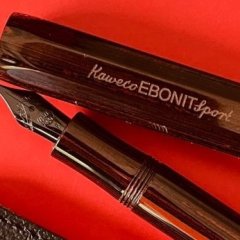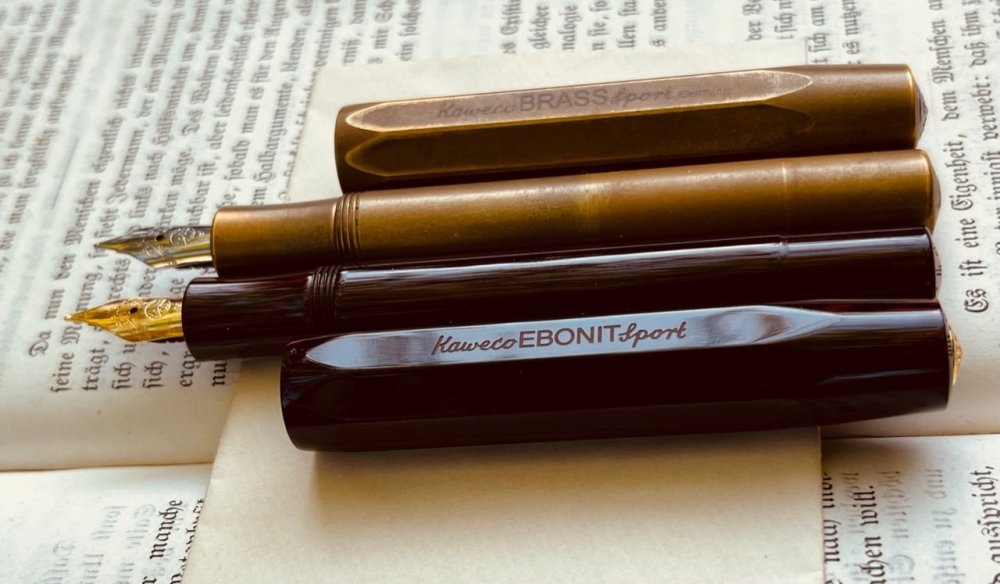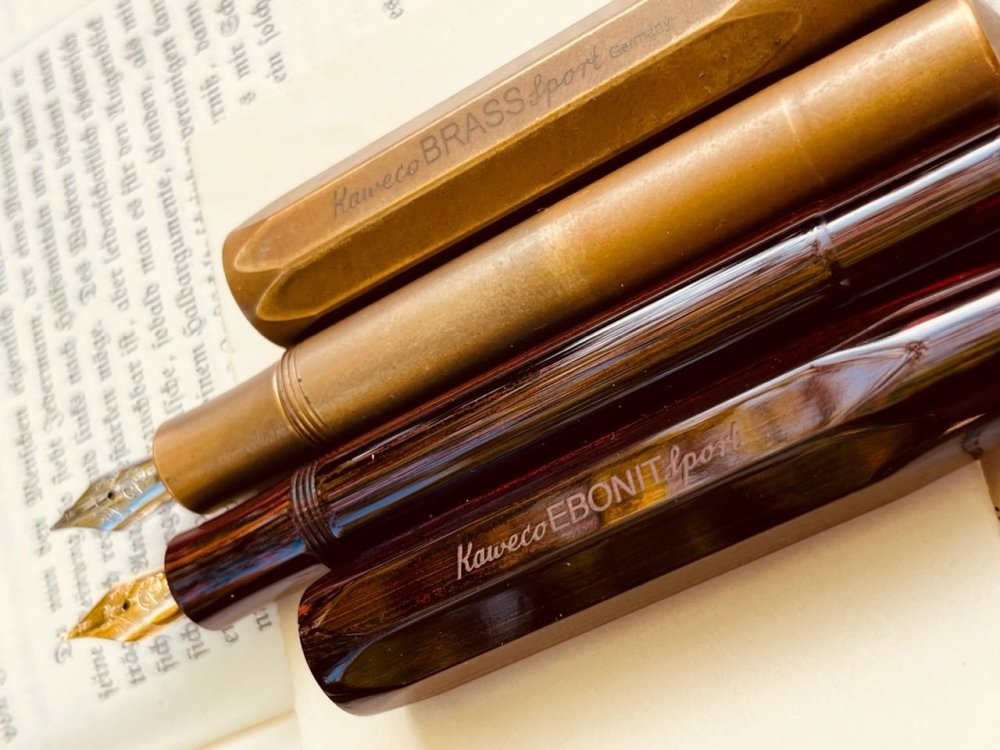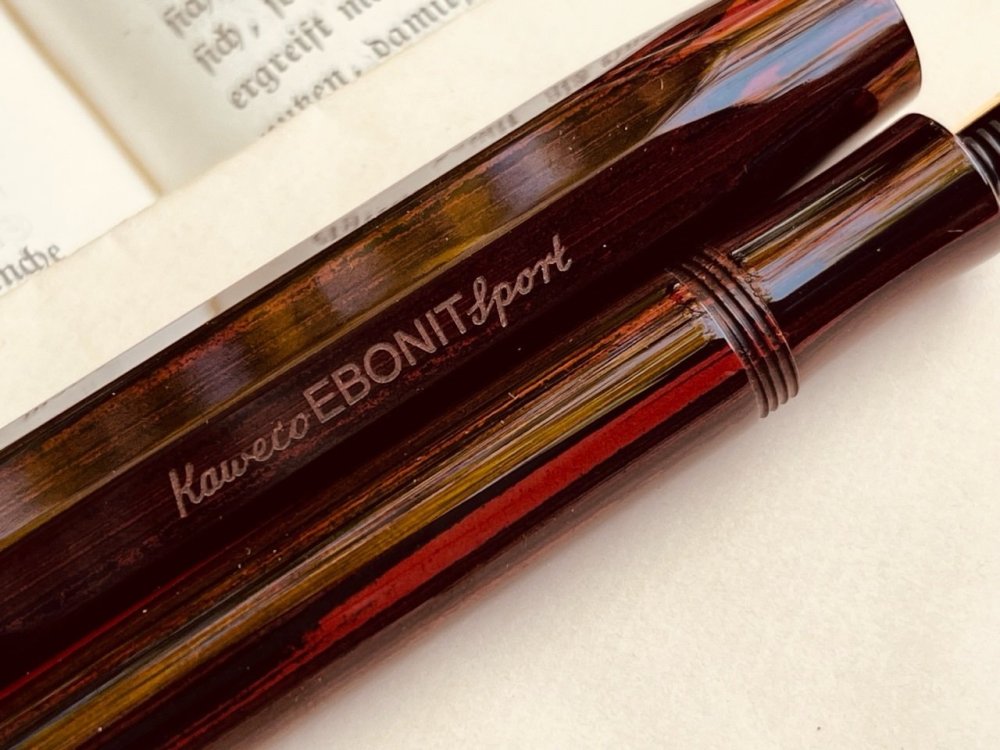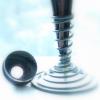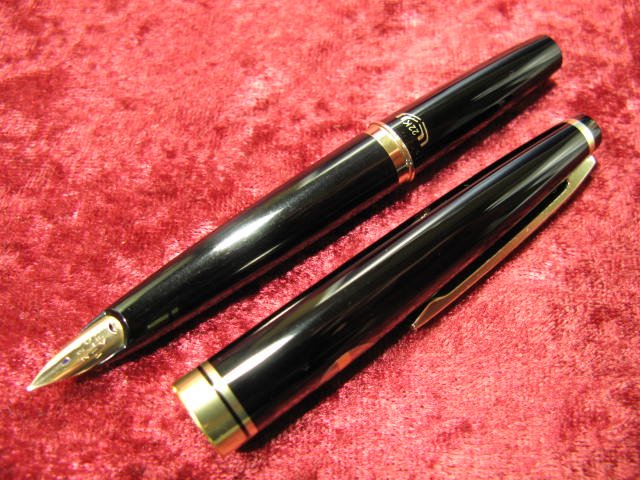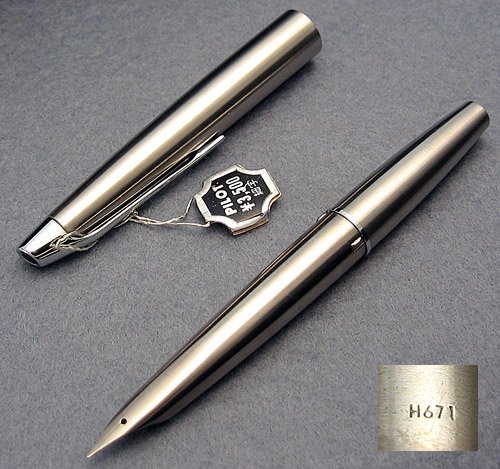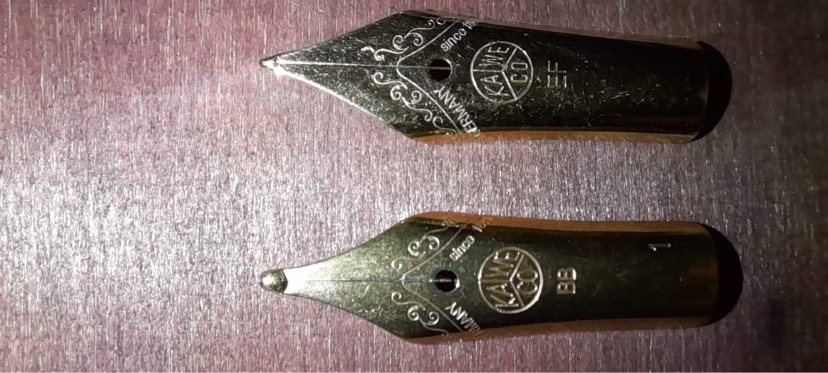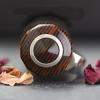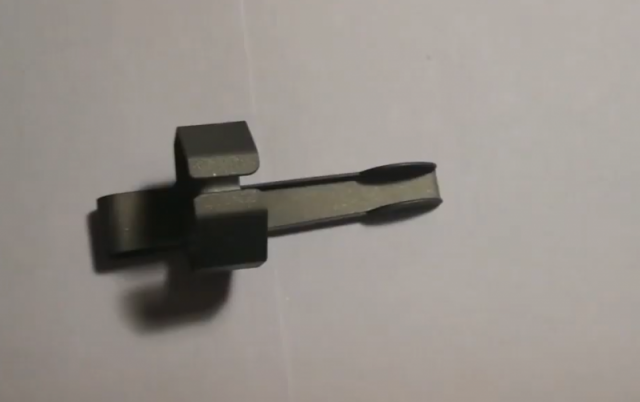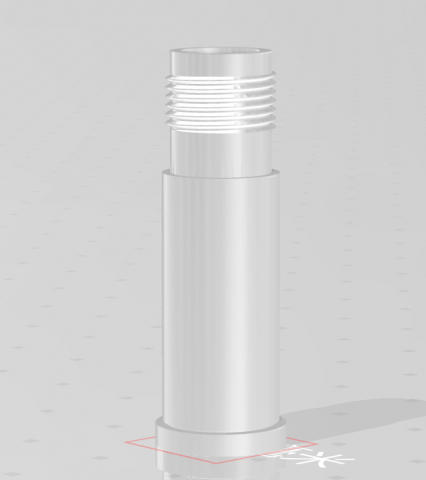Search the Community
Showing results for tags 'kaweco'.
-
First of all: My passion for fountain pens has been with me for more than 25 years now and has therefore changed many times: from classics from Germany to the pretty colorful divas from Italy to the noble Japanese fountain pens and back again and back again. In the meantime, a small core collection has emerged, but there have been no constants throughout this time - with one exception: No matter in which collecting phase I was and where my preferred collecting area was, different models of the Kaweco Sport have been added again and again over the years. It started when I first saw such a fountain pen at Manufactum in Hamburg a good 20 years ago (black in checkerboard pattern or diagonally striped). Since then, this concept of a pocket fountain pen has not let me go and I personally still feel the Kaweco Sport as one of the greats in this segment - literally, because unlike the vast majority of other real pocket fountain pens, the mini-converter fits inside and that is simply ingeniously solved for me. Since I first came into contact with vintage fountain pens in Vienna in 2007, the desire for a Kaweco Sport in ebonite has been germinating, which I have also included here in some reviews from time to time over the years. And now suddenly - to my really big surprise - it is actually so far. When I came across the topic of Sport Ebonit the other day at in Münster while talking shop with Mr. Hille and Mr. Thoben, and there was actually news on the topic, I was very happy. And to let you share in my joy in this regard, I have made you below quite a few pictures J Actual Review: Packaging: The 140th company anniversary set comes in a cardboard box with gold embossing of the company logo and name. Wrapped in black wrapping paper, it contains the usual booklet with care instructions, a sticker, a booklet with the company history, a 10 cardboard box with cartridges in all current Kaweco ink colors, the actual fountain pen and separately the gold logo clip (personally I would have wished for an additional converter and a leather pouch). Body: This lovely piece is light... very light... my scale reads 9 grams. For comparison, the plastic version is also 9 grams, the aluminum version is 19 grams, and the brass version is 45 grams.... The other dimensions are identical to those of the other Kaweco Sports, though subjectively I have the impression that the Ebonite feels narrower in the hand and even lighter than the plastic Sport; my calipers and scales prove me wrong in this regard, though: identical weight, identical dimensions.... Material: Eboniiiiite! Wonderful! I like the material very much - generally ebonite, but also specifically this (brownish)red-black version. (I'm always tempted to say 'red ripple', but it's not a 'ripple' pattern at all, rather simply striped). It feels wonderfully warm in the hand, is excellently polished and yet not slippery, not even at 30° outside temperatures with sweaty fingers, which is why it was used for so long especially for sections (and is still sorely missed by me there today). By the way, a polite inquiry to Mr. Wunschel (Head of Marketing at Kaweco) brought to light a small overview of the material history of ebonite at Kaweco: The last Kaweco made entirely of ebonite was the Colleg #603 in 1937-45, and the Sport still had an ebonite cap in 1952-58 (the barrel was celluloid at the time ). Possibly more importantly, however, the first Kaweco Sport was also made of ebonite - in this color scheme. By the way, both the material and the production of the fountain pen are based in Germany. They are old stocks that senior boss Michael Gutberlet had stored for a suitable opportunity. In February of this year, the opportunity then apparently seemed appropriate, because there the idea of an Ebonit Sport for the 140th anniversary was born (- at this point my thanks for the effort of research to Mr. Wunschel) Nib & Feed: Standard gold plated Kaweco steel nib unit. Opinions will differ here. Those who don't like the rather dry ink flow and the comparatively small nib per se will also be bothered by this. Others would certainly have liked a gold nib for this version. Personally, I find the gold nibs from Kaweco in no way superior to the steel nibs in their writing characteristics and am therefore rather pleased with the steel version, especially since there are various hand-ground stubs here that are easily replaceable and fit the fountain pen well. I actually wouldn't have liked the surcharge for a gold nib here. In addition, the company remains pleasantly true to itself in this regard: the other special editions, such as the recent Bronze, also have the steel nib ex works. Fit & Finish: Impeccable. There's really nothing to complain about: Threads perfect, polish flawless, company and series names pin sharp, cap logo picobello. The cap - in contrast to my Sport brass - does not have an internal ring that ensures that the shaft is centered in the cap, yet the shaft has symmetrically the same amount of distance to the cap all around when the cap is screwed on. And don't worry, nothing will dry out: an inner cap to seal the nib at the top of the cap is also available in ebonite. The areas around the internal thread of the grip to the body are not polished, which provides a little more grip when screwing. I can't say if it's suitable as an eyedropper like the plastic Sport models, but if you want to try it out: be careful with Vaseline! If I remember correctly, petrolatum is not compatible with ebonite. But overall, this eyedropper thing at Kaweco is fun, especially with the transparent plastic versions, because you can keep an eye on the fill level. Price: Prices vary greatly on the web: among European suppliers, everything between roughly 280€ and 350€ is in there. As with all other fountain pens from all other manufacturers, the same applies here: One can argue about it. If I look at the current models in ebonite from other manufacturers, we are usually similar in price or above. In this respect, everyone can form their own opinion. Overall impression: I said at the beginning that I was very excited about the announcement. And the overall package fully lives up to my expectations. I especially like the details: I like the simple, contemporary and environmentally friendly paper packaging. I like that it doesn't have one blue cartridge in it, but a whole package. I especially like that it's a test pack with all the colors. I find it extremely convenient to be able to easily test through the ink assortment within the scope of delivery, without having to buy a pack of cartridges each time, only to find out that the color on the paper is quite different than the pack suggests. I like the enclosed clip, and that it's not pre-attached because it would involve scratching, which some would probably want to avoid. And most of all, I like the fountain pen: this classic and pleasant material just fits this classic fountain pen design perfectly. I would actually like to see more Ebonite special editions in the future; for example, a black version with the diagonal stripes that have still been available at Manufactum for over 20 years – but now in ebonite. Anyway, I'm looking forward to the new materials in the next few years with the Kaweco Sport series, which hasn't gotten boring for me one bit since its introduction. And now for the long-awaited pictures: (No affiliation - just a happy customer)
-
Quick comparison of two similar inks I happened to have. Both write and behave really well, although similarly not great on cheap paper. The swabs are pretty shabby because I only have Summer Purple in cartridge form, so I couldn't get much ink on the cotton swab. I made the Poussiere de Lune swab the same way by getting it from the converter instead of dipping in the bottle. Both are great inks, I might prefer the color of the Herbin slightly more. Hard to tell on such wet fine nibs but the color differences are noticeable when they shade to their lighter tones. School notebook paper, the color difference is a bit more noticeable. Both spread and bleed through almost exactly the same way (56g/cm³)
- 17 replies
-
liliput Hacking Kaweco Liliput pens for the perfect drawing tool
Juz posted a topic in Fountain & Dip Pens - First Stop
Back in the 1990s I used Waterman pens with #2 nibs for drawing, which seemed to be the most perfect tool — but they frequently leaked and had problems. I didn't get back into fountain pens until recently when I started to hunt for flexible nibs again on a modern, more reliable pen. First I discovered Fountain Pen Revolution flexible nibs, which are great, but then I found that I could also insert vintage Waterman nibs on some modern pens, which was a revelation. The problem was that the FPR pens are so leaky and unreliable, and both nibs always seemed to be starving for ink in various pens I found. Enter Kaweco Liliput. I discovered that their #5 nib/feed was a perfect size for the FPR and Waterman nibs, but I needed to improve ink flow. I also found that the pens are too short for quick sketching (without having to cap them). So I: • Bought a second set of each pen so I can use the cap as an extender • Drilled a hole through the back of the body so a standard ink converter will fit the pen • Altered the feeds so the ink channel/gap was wide enough to accommodate steady ink flow. (I melted the channel with paperclip attached to a soldering iron so the gap was about 2mm.) • Used a flame to "blue" the stainless steel pen, which made it kind of yellowish and colorful • Patina'd the copper pens by soaking in an ammonia bath, which has now mostly faded • Used a cap from a brass "Space Pen" to extend one of the copper pens, instead of another Kaweco cap (and each extra set is not cheap at ~$65, and I am only using the extra cap). Soaked that in ammonia as well, and it's stayed blue-black for a while now I now feel that these are perfect drawing pens (other than the fact that you cannot cap them on the end, which is a minor issue for me). I love using ink converters with flexible nibs since if it the pens stalls you can just shoot a bit of ink with a turn of the dial on the converter. I also find that converters are the best way to experiment easily with different inks. The feel of the copper is really nice and the color keeps changing. A gold Waterman nib in a copper pen is just sublime! Has anyone else hacked their Kaweco pens? -
Here I present to you all a vintage mid 1950's MAHAG piston filler by Kaweco FOA , thanks to all the vintage Volkswagen fan over at multiple automotive online groups and forums who answer my questions and give info For a bit of History , MAHAG is a major automotive dealer in Germany starting out in 1930's and still around today, after the war they center all theirs on Volkswagen and added Porsche. Just as any other of such they give company branded merchandise to customers and also employees. This pen as far as info and speculation goes ( according to the Volkswagen fans ) was only given to priced customers who purchase up market model like the Karmann Ghia, Porsche or the full option Beetle or the famed 23 windows bus and also likely to distinguished employees. It's actually a rare item accordingly. A fascinating and interesting piece of automotive and fountain pen memorabilia. This pen was OEM manufactured by Kaweco and everything tells , the piston mechanism had the distinctive pin through the knob construction and the whole pen exhibit a variety of the Sport model's character. It had the model 12's piston mechanism but it's got the early post war 112 construction of mix celluloid + ebonite BHR. It had a Bock 14C gold nib that is fine and surprisingly soft and almost full flex. With an all round cap with the MAHAG logo Technicals and restoration info on coming post
-
As mentioned in another thread -- -- the parcel my brother'd sent me from the States arrived after a little more than a month in transit yesterday. At around 11:20. I put away the notebooks and checked out the two gel pens and gel-pen refills and finally came to the Kaweco M nib. I pulled out my Kaweco Special, took out its EF nib, and installed the M nib. Inked up the pen. Noodler's Black, duh. Wow. What a wet nib! Much more like a B line, or maybe M lines have always been so fat. Set the pen aside, cos I had changed the ink in a Pilot 823 (PO), from Pilot Blue-Black to KWZi Niebieski galusowy #3, tra la la... la la la... picked up the Kaweco Special, and... fumble-fingers dropped it straight down onto the floor. It was 14:42. I couldn't help but laugh. Here, it'd taken this nib over a month to reach me (and I could have ordered one more cheaply from one of my favorite "local" (in Kraków) pen shops) and not even two-and-a-half hours later, I'd turned it into...hey, that looks like a PO nib! Hahahahaha. I wasn't crazy about the M nib and had been thinking of modifying it (by a professional), and I feel sooooo lucky that it was the Kaweco that I'd fumbled and not the Pilot 823. Or the Nakaya Piccolo (also on the table at the time). I took the nib out of the Special and bent it back about halfway before sticking it into an AL Sport, for further testing. It still looks like a PO nib and writes with a tiny bit of scratching, nothing a little more tweaking couldn't fix. Probably. So... what have y'all dropped lately?
-
Hi everyone, It's great to be part of this fountain pen community. I rediscovered my love and passion for fountain pens recently. Coincidentally, I got my first pocket pen (Kaweco Sport, Bordeaux, medium nib) with Kaweco Caramel Brown ink cartridges and a mini piston converter today. And I must say that I am loving the experience of writing with it. It has an old world charm to it, which is accentuated by the colour, golden nib and clip, not to mention the unique design and utility. I am sure this is not my last Kaweco Sport. I may consider getting a Brass Sport later. But, I guess a Sailor Pro Gear Slim isn't very far in the future. I tend to gravitate towards retro and vintage stuff. Looking forward to some great conversations here.😊 Cheers! Ajay
- 18 replies
-
- kaweco
- kawecosport
-
(and 1 more)
Tagged with:
-
As a pen (and ink) afficinado that lives in Austria, it amazes me, that so many inks are made locally here, even though there is basically no high quality fountain pen and ink production by Austrian brands. There are cheap (and somewhat ugly in my opinion) "Jolly" branded school pens, and the quite nifty Jolly branded ink cartridges (they fit international standard on one end, Lamy on the other), but really nothing worth mentioning on this forum. And then there ist the "mysterious Austrian OEM producer" that does at least ink for: Montblanc Kaweco Monteverde (i am almost sure, I have thrown away the packaging though) Online and probably others. I suspect that this manufacturer ist basically the one company that in the last 30 years has consolidated all Austrian stationery producers(with brands JOLLY, SAX, Cretacolor and BIBA). Again the ink/fountain pen production was never worth mentioning, but the predecessors to that corporation had a centuries long tradition in producing pencils, and their pencils are still very good today (Jolly is a brand aimed at the school market, but their coloured pencils are very good, as are the "Cretacolor" branded artist pencils). I have no evidence to confirm that this is the producer of above OEM inks, would love to hear from anybody who knows more In my much too large collection of inks there are several of these Austrian inks mentioned above, today I swabbed three reds, because I've just bought Kaweco Ruby Red (mainly because of the nice new bottle). Another, probably less known German brand is "Online", their red is called Ruby too, and I was wondering if it is the same, as I suspected could be the case with "Monteverde Valentine Red". As you can see, Kaweco and Online/Monteverde are actually quite a bit different. Monteverde *might* be just a bit watered down Online ink or batch variation, or just an ever so slight variation. I am actually surprised by Online Ruby being such a strong true red, without any hint of blueish or yellowish cast. Is Montblanc red still "Made in Austria", has anybody made comparisons to one of the inks mentioned above? None of these inks is very cheap (don't know about Monteverde, it was expensive to me mainly because of shipping), most of them are quite saturated (as is e.g. Montblanc royal blue). Somehow I am phantasizing about sneaking into the Sachs&Brevillier factory building, discovering lots of ink secrets Does anybody here have more information about that mysterious producer? Should I buy Montblanc Modena red to compare I think the new Kaweco bottle (it is basically a jam or marmalade bottle with its twist off cap) is great BTW, it brings ink price somewhat down too. It is 50ml now, instead of 30ml before at the same price. a nice weekend to all ink-afficionados, Ralph
-
I have been collecting writing instruments for a few decades and currently have about 300 of them in my collection. They are mostly vintage, and a few new ones. I try to follow technical evolution as themes of my collection such as filling mechanisms, nib characteristics, materials, etc. I recently became interested in pocket fountain pens and I really don`t have much knowledge about them, so I propose to start with what I know and perhaps members of the community can contribute. There are examples of writing instruments of the Victorian Era, that were meant to carry in pockets or pouches, such as telescopic mechanical pencils, dip pens or combination instruments. At the turn of the Century Safety fountain pens came about, in an attempt to prevent ink spillage when carried in a pocket or pouch. For the most part, these pens were of large size for a pocket. For the purpose of this discussion, I would like to propose the following definition. A pocket fountain pen is one that is short enough to fit in a pocket comfortably and by some means it is enlarged to become comfortable for writing. To my knowledge, there are to methods to achieve this purpose. 1 - Pens with a short barrel and long cap and long section. The threads of clutch ring where the cap engages with the barrel is at the end of the long section, so when capped they are short enough to pocket and when posted they become long enough to fit in the hand. 2 - Telescoping fountain pens. The first example of short barrel and long cap that I am aware of is the Kaweco Sport, that appeared in this format in the 1930's as a piston filled fountain pen with a matching mechanical pencil. Since the pencil doesn't require a cap, the concept doesn't apply to it and it ends up being just a short pencil. This pen is 4" capped and 5.5" posted. In the 1960's in Japan Sailor Pilot and Platinum started offering beautiful renditions of short / long fountain pens. The Japanese development of these pens is covered in depth in Richard Binder's e-book Japanese Pocket Pens. Below I show a Pilot Elite and a Pilot MYU from my collection. While telescopic dip pens where common in the late 19th Century, the first telescopic I am aware of is the Pilot telescopic fountain pen in the 1960's. There are probably earlier ones. In the mid 2000's, rOtring came out with telescoping fountain pens, mechanical pencils and ballpoints, the model Esprit Mini, which is currently produced by Parker. I am sure there is much more to this story than what I was able to present here.
- 22 replies
-
- pocket pens
- kaweco
-
(and 2 more)
Tagged with:
-
Hi, I am a new member of the forum, I joined because I thought I could find some help regarding my post below. The link should take you to my original post. Basically, I have been looking for a specific Kaweco AL Sport that is no longer produced, with no success. I am hoping there is still a possibility of finding it. Many thanks... https://www.fountainpennetwork.com/forum/topic/358638-looking-for-kaweco-al-sport-fountain-pen-in-matte-blue/
-
Looking for Kaweco AL sport Fountain Pen in Matte Blue
saadmn posted a topic in Other Brands - Europe
Hi, Is anyone able to get the pen mentioned in the title? If so, I would greatly appreciate it and I will pay for the cost and shipping, and any extra cost towards the effort made to find it. I live in New York. Regards. Note 1: Kaweco now makes this AL sport fountain pen in a "stonewashed" blue color, which is not as distinctive as their matte blue version. Note 2: A used one in very good condition is also an alternative if finding a new one is impossible. Note 3: An example of what it looks like: https://www.jetpens.com/Kaweco-AL-Sport-Fountain-Pen-Matte-Blue-Extra-Fine-Nib/pd/9493 -
I was wondering if I could see your kaweco double broad nibs? I’m a little worried that I got a fake one 😕 my double broad has deeper etching and slightly wider design than that of my EF (which came from germany). Also, the etching it slight bronzed. Doesnt show in picture but noticeable when observed keenly in person. Also, it took me 30 mins for it to write. Then I have to squeeze the catridge everytime I want to use it. Never had a problem with my other kawecos.
-
InkShift - Kaweco Ruby Red to Sunrise Orange Just for the fun of it, I decided to do a project exploring what happens when you move progressively from one ink colour to another. For now, I'm restricting myself to inks from the same manufacturer - mainly to avoid nasty chemical surprises. My hope is that some of these "inkshifts" result in interesting colours that I can use to write/draw with. And besides... it's just fun to watch one ink colour morph into another one. Ruby Red and Sunrise Orange are regular Kaweco inks, but not especially interesting. The Ruby Red is definitely not to my taste, and the Sunrise Orange is just plain orange... I don't see the soft beauty of a sunrise in this colour. But maybe there might be some interesting combinations in the mix, maybe even a fairly decent red-orange. Who knows... only one way to find out, and that is to do the inkshift experiment. In the span between the two starting inks more interesting colours appear, that beat the original versions (my personal opinion). The ones that I liked the most are the following two: The first one is a soft orange-red, the other a decent sunset orange. I prefer these mixes to the original Kaweco inks, and will use them instead. I continue to enjoy these ink morphing experiments. Fun adventures in ink-land, and more often than not you are rewarded with a mix that beats the original inks. Fun guaranteed!
-
How long does it take for the Kaweco fountain pens to ink the first time? I inserted the cartridge that goes with it but its not writing The ink in the cartridge is not dry. I have shaken the pen and everything and no ink is coming out. Im leaving it pointed down waiting for the ink. I'm using a double broad nib.
- 6 replies
-
- kaweco
- double broad
-
(and 1 more)
Tagged with:
-
-
InkShift - Kaweco Palm Green to Royal Blue Just for the fun of it, I decided to do a project exploring what happens when you move progressively from one ink colour to another. For now, I'm restricting myself to inks from the same manufacturer - mainly to avoid nasty chemical surprises. My hope is that some of these "inkshifts" result in interesting colours that I can use to write/draw with. And besides... it's just fun to watch one ink colour morph into another one. Palm Green and Royal Blue are regular Kaweco inks, but not especially interesting. As far as I know, Kaweco has no teal inks in its line, so I decided to explore if a decent teal is in the mix. Green inks appear to be very dominant ones, so I explored on the blue side of the spectrum. Some interesting combinations arise, certainly more interesting than the plain ink versions I started with. In the span between the two starting inks, some interesting colours can be found. My personal favourites are:1 part Palm Green, 7 parts Royal Blue : a Prussian Blue style colour1 part Palm Green, 4 parts Royal Blue : a blue-leaning tealI really enjoy these ink morphing experiments, the results are often surprising and a lot more interesting than the original inks. Loads of fun! Doing an inkshift is easy. All it takes is a couple of pipettes, some receptacles, Q-tips and a fountain pen. And a couple of hours of free quality time to run the mixing experiment. You should try it... a fun experience.
-
Shadow nibs make for interesting writing, but they are really a useful tool when learning a script written with a broad nib. They make your nib angle and stroke direction more obvious. Thus, they make it easier to identify (and correct) errors. David
-
- broad nib
- shadow nib
-
(and 3 more)
Tagged with:
-
Shadow nibs make for interesting writing, but they are really a useful tool when learning a script written with a broad nib. They make your nib angle and stroke direction more obvious. Thus, they make it easier to identify (and correct) errors. David
- 3 replies
-
- broad nib
- shadow nib
-
(and 3 more)
Tagged with:
-
Which converter fits the Kaweco Dia2 pen (with the standard Bock 060 nib unit)? Kaweco have 3 types on their site - mini for the Sport, squeeze and standard. I bought a standard Kaweco converter but it doesn't remotely fit the pen - it won't even fit in the metal base of the section. Other converters in my possession don't fit either. I've seen this asked a few times but couldn't find it answered.
-
I have an old Kaweco Dia 805 (late 1950s or earlier is my guess). When I got it (ebay), the cap was loose but after soaking the pen in water to clean it, the cap fit perfectly. This was temporary. After a few months the cap is loose again - so loose it falls off. Curiously the blind cap does not have this problem only the section cap. The cap of the pen looks to be plastic - as is the body - but the thread area below the ink window is faded brown. Could this be hard rubber and water absorbant? Is there any non-harmful substance, apart from water, that will keep the threads 'plump' and well fitting for a long period?
-
Disclaimer: My reviews are about vintage pens I've been collecting for many years. So, please don't expect you can rush to the store or go online to find that particular pen I'm talking about immediately. Also, vintage pens will always be an adventure and in my opinion that's part of the fascination. Even if you find the same model, there's no guaranty that it will behave the same way as described here. Background: Kaweco as a brand name has made an amazing renaissance in the past several years since the original company went belly up some time in the 1980s presumably. Due to the efforts of H & M Gutberlet, several model names and the brand name have been resurrected but I believe that most FP users never got in touch with the original versions of a Kaweco Dia or Kaweco Sport to name only two of their most prominent model lines. So, here comes a short review of one of the ancestors, a Kaweco Dia 85. The model name "Dia" was introduced in 1934 to point to the clear ink window that became possible due to the new piston filling mechanism. Before the Dia, the Kaweco pens were safety, lever, or button fillers. Since then there have been numerous versions of the Dia and even models sharing the same model number can have different designs. The model I'm presenting here is a Dia 85 with FK ("fein/Kugel") nib. It also has a "101" imprinted on the barrel and I have no idea what that refers to. In fact, I have a second Dia 85 with M nib that is almost identical except for the position of the two narrow cap bands. This second Dia 85 has a "52" imprinted on the barrel. But now for the actual review. The outer values (design): This Kaweco Dia 85 was presumably produced roughly between 1946 and 1954 and is a typical representative of the German elegant black piston filler of the era. Anything colourful would have been considered extravagant or frivolous! It measures 125 mm capped, 117 mm uncapped, and 142 mm posted, quite a typical size for the period. The barrel is indeed slightly barrel-shaped with conical domes at both ends and with a short section, which is 9.2 mm at its thinnest (near the nib). The widest girth of the barrel is 11.8 mm right behind the ink window and the cap's girth is 13.2 mm. The piston knob is hidden by a blind cap and the piston mechanism is screwed into the barrel such that there is a 7 mm wide section of the barrel belonging to the piston housing. The imprints of the model number "85" and the nib type "FK" are on this visible ring, which is kind of a design element. To make it visible, the edges of the piston housing are very slightly knurled. There is another imprint on the barrel reading "Kaweco-Dia" which once had been gold but the paint is partially rubbed off. I probably should mention that this is a very well-used pen, a real daily worker. The ink window used to be green but has darkened almost completely, which is very common with these pens and presumably due to the use of iron gall inks over many years. The cap sports two narrow gold plated cap bands, a decorated clip with the "Kaweco" brand name, and an intricate inlaid gold plated finial in the cap screw. Both cap screw and blind cap are knurled and have a conical domed end. The cap also has two breather holes as typical for the era. The pen only weights 15.9 g and this light weight is due to the entire pen being made of celluloid with very few metal components. Finally, the pen is fitted with a 14k semi-flex gold nib with the imprint of the KAWECO logo together with "WARRANTED" and "14c-585". The inner values (technical stuff): The patented screw-in piston mechanism consists of the housing with a square inner boring, the piston rod with a square outer shape, a cork ring as seal held by a plug, which is fixed by a metal pin through the piston rod, the piston spiral inside the housing, and the knob attached to the spiral with another metal pin. The mechanism is rather simple but well-made and functional. It has been used with only minor modifications by Kaweco well into the 1960s. Expect that the cork seal has to be replaced after roughly 70 years! I did it for this one and recommend to be extremely careful or send it to an expert. Due to the construction, you can easily crack the barrel end when trying to unscrew the piston housing or crack the piston rod when knocking out the pin holding the plug of the cork seal. Anyway, with a good, working piston seal in place, the filling works flawlessly and probably will so for the next 50 or so years. If the old seal still works (sometimes after extensive soaking), I recommend to keep it wet all the time to prevent it from shrinking. By the way, the measured ink capacity is roughly 1.0 ml. Performance and balance: If you're not used to vintage pens of this kind, it might appear at first like you have nothing in your hand because it's so light-weight. It's also quite small compared to many modern pens. But once you get the knack of it, it's awesome. It's no different with this Kaweco Dia 85. In fact, it has the almost perfect balance for me, both unposted as well as posted. But I usually don't like to post my pens. When writing, my forefinger might rest on the threads but this doesn't irritate me. I don't feel the threads because I have a very light grip, maybe a result of writing with vintage pens all the time. So, the balance is nearly perfect, what about the writing performance? I'd say as close to perfect as it gets. Writing with this pen is completely effortless. The ink simply flows and even won't make a mess on crappy paper, though it is a medium wet nib (and feed) when compared to other pens of the era. There are no hard starts and no skipping and absolutely no pressure is required. This means that I can write for hours with this pen without the slightest sign of fatigue. I also can write very fast without any problems. And I won't need to worry when taking a thinking break because even without capping the pen for extended periods, it will start writing without any problems. The nib iteself I'd call semi-flex. It won't flex when used in normal or fast writing mode but you can flex it moderately if you want and it will give some line variation (maybe 2-3x). But it's quite clear that this nib was not meant for flex writing. However, the springiness of the nib results in a very nice writing feel together with the smooth tipping that gives just the right amount of feedback even on very slick paper like Clairefontaine or Rhodia. So, it is a little toothier than many modern pens with highly polished nibs (and all the problems that come with this). It's probably comparable to many Aurora nibs regarding feedback. On non-absorbent paper, the nib puts down a truely fine line when not flexed. The "Kugel", meaning sperical, tipping assures that the line has the same width in every direction. It was meant for people who cannot control the "rolling" of the pen and was a specialty nib in the era. The typical German nib till at least the 1960s was more chisel shaped what might be called a stub or cursive italic today. Anyway, the FK nib certainly would be a good choice for a beginner because it's very forgiving. Note: The top pen is the one I just restored and described here with the FK nib. The bottom pen is the mentioned second Dia 85 with M nib, which is not restored yet. I only repaired the badly bent nib so that it would write again. Conclusion: This is an absolute keeper, a very well balanced pen with an excellent nib and flawless filling mechanism. The design is rather understated but shows a lot of love for details if you are willing to look for them. Despite its age, it is an excellent EDC pen and I use this or similar pens all the time, these pens were meant to be used.
-
Spoiler alert; my search for the ideal beginner's pen is over. Well at least for now 😅 This was a pen I got from the proprietor of one of UAE's two pen shops, Pens Corner, at the Pelikan Hub 2019 in Abu Dhabi. Though people consider this as an insanely inexpensive pen, I had to think over it for a while since my pen budget is pretty low and I am not accustomed to pens this size. People who know me well would know that I love oversized pens the most as majority of my pens are Indian oversizes in ebonite. So this pen was really a gamble, but I totally hit the jackpot with this one. Design and Appearance: The Kaweco Sport debuted in 1911 as a pocket pen. The modern iteration has an octagonally faceted cap and a round barrel that ends in a slight conical shape. Both of these are almost equal in length, however, the cap is much wider in diameter. This allows for the cap to post, rendering an otherwise puny pen totally usable. The cap tapers slightly towards the top and has a conical insert on it. It also bears 'Kaweco Sport' on one of its facets. The barrel ends with an edge is ridged. Mine has an aged appearance and I feel adds a nice vintage charm. The section is designed to be concave and is proportionally aesthetic to the body. This pen is not going to win any beauty contest, but that's not the point. This pen is meant to be functional. And functional, it highly is. The pen doesn't come with a clip but you can buy them separately. They are available in two designs, and I got the vintage styled curved clip. This clip is IMHO one of the best looking clips out there. The end is diamond shaped and has a few engravings. The clip attaches with a ring like thing that is also faceted to match the facets on the barrel. The facets on the clip has 'since 1883', the Kaweco logo, and GERMANY engraved on them. I'll be entirely honest here and say that I got the clip only for the looks. The functionality is somewhat limited as the clip tends to come off the cap when you apply more force to clip the pen. I avoid this problem by putting my index finger against the top of the clip and then it clips with no issues. Construction and Quality: This pen is made of a sturdy plastic that I recall reading as ABS. At this price point, you shouldn't really expect any remarkable finishing and this pen certainly shows it was made to fit a price point. The polishing isn't the best, as there were a few visible micro scratches on the barrel that has accumulated even more scratches where the cap posts. I baby all my pens so this hasn't scratched up as heavily as a friend's Ice Sport that he carries around in his pencil pouch along with other things. Filling System: The pen is designed to take both cartridges and converters. But the size means that it can only take some of the mini converters out there and I'm not sure it'll even take a long International cartridge. You can eyedropper fill this pen but it dose have a caveat, that ink seeps in through the section and friction fit nib collar and leaks out through the end of the section. But this does have a fix. Using the cartridge that came along or any empty cartridge as a knockout rod, you can knock out the nib collar and grease it with silicone grease. Now you can safely ED your pen and enjoy the high ink capacity and increased ink flow Nib and Writing Comfort: Here's where the pen doesn't kid you. The nibs on these are stainless steel, from Bock and are engraved with all the things as on the clip, and also the nib width. The feed is plastic. My medium nib came perfectly writing with average wetness and a light feedback. While totally usable as it was, I smoother it a bit and increased the ink flow since I prefer uber smooth nibs with a really wet, almost gushing ink flow. The writing sample is with Camlin Blue. Since it is a pocket pen, the section on it is a bit small for me and feels a bit thin but I also have bear paws for hands 🤷♂️ Final Thoughts: This pen is appropriately priced but I really cannot understand why the clip isn't provided and costs as much as it does. I mean there are pens much cheaper that come with sturdy clips. I wouldn't consider this a fair argument though since the pen is meant to be tossed around and not clipped to your pocket, so I'm not complaining. I also get that some people have had terrible experiences with their nibs with dryness and baby's bottom being the most common. But I cannot deny that I love this pen. Much more than the Pilot Metropolitan, Lamy Safari and family, or the TWSBI Eco. In fact, I've got a second one, the Goldspot exclusive turquoise demonstrator that is currently with a friend. Just waiting for this coronashit to die down and normalcy return to this world.
- 16 replies
-
- kaweco
- kaweco germany
- (and 8 more)
-
Hello from the "Live Free or Die" state (New Hampshire), Older professional guy who is a fountain pen user. Interested in pens that write immediately and smoothly. So far, Kaweco and platinum preppy, ( yes, I mean it), fit the bill. Am wondering if anyone has tried the Visconti Homo Sapiens Magma fountain pen , to which I am very attracted? Am willing to be convinced the pen is worth the seemingly high price. Am also wondering if anyone has written with both Noodler's legal blue and Noodler's legal lapis inks, and, whether and why one is preferred over the other Any thoughts you may have would be greatly appreciated. Thank you. Kind regards, Henry
-
This pen arrived today, and I was pleased to find it a much lighter blue than the royal blue I had been expecting. Its verging on an ice blue. Is this a change, or have all the photos Ive seen of this pen misrepresented the colour? Even this picture makes it look several shades darker and more vivid than it really is.
- 14 replies
-
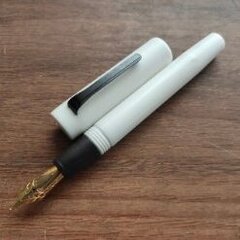
Success In Kaweco Titanium Clip 3D Printing And Next Step
VonPG posted a topic in Fountain & Dip Pens - First Stop
After 3 times failure I made it at last. By using EOSINT M280 printer, a titanium clip was printed. To make it looks in matte finish. I polished it for one day and it looks great now. Clip Clip after install it to Kaweco Ti My next step is to creat a pen by using 3d printing and CNC machine. And I draw some stl file here. Cap Body Grip The Whole Pen I have tried many times to print prototype in resin like nylon12 or acrylic, but its accuracy is not enough. So next time I decide to print or use cnc machine in Aluminum, Sterling Silver or Alumina Ceramic. And I also want to design some pattern to make it looks more attractive. But due to the outbreak of disease. I can only stay at home now. :-P -
Pen Pit Stop : Kaweco Liliput Fireblue Welcome to the Pen Pit Stop. Here you will find reviews of pens that already have some mileage on them. More specifically, these reviews are of pens that are in my personal collection, and that have been in use for at least a year. I thought it would be fun to do it this way - no new & shiny pens here, but battered vehicles that have been put to work for at least a year. Let's find out how they have withstood the ravages of time. The fountain pen that enters the pit stop today is the "Kaweco Liliput Fireblue". Kaweco is a well-known German pen company, whose history dates back to 1883 with the foundation of the Heidelberger Federhalterfabrik (Heidelberg dip pen company). The brand is best known for its pocket pens of the Sport and Liliput range. As early as 1905 Kaweco had already manufactured the first writing instruments made out of metal. This tiny pocket pen is made from hardened steel with a hand-torched finish. I bought th Fireblue in November 2015, and it has been in rotation as an EDC (Every Day Carry) pen since that time. This is one of my older pens, which has been in use for over 4 years now. Let's have a closer look at it. Pen Look & FeelThe Liliput is a great EDC pen with a truly minimalistic look: no ornaments for this pen except for the Kaweco logo on the cap's finial. Etched on the side of the cap is the pen's designation "Kaweco Liliput Germany". The pen is truly tiny - I typically carry the Liliput in my pocket along with my keys. The Fireblue is basically a steel pen, and can take a beating. You don't have to worry about damaging it. The Liliput Fireblue is so named because the finish is literally born out of fire. The pen is hand-torched, and in the process gets a unique pattern with steel, blue, purple, orange and brown hues. Unfortunately, you have to pay a hefty surplus for this special look (149 vs 79 EUR for the regular steel pen). When the pen was new and shiny, the torched material looked wonderful with a rainbow of fairly bright colours. After four years of use though, the colours have faded substantially and the pen now looks quite dull and unattractive. This one doesn't age gracefully - a world of difference with the Liliput Copper. When you're ready to use the pen, just unscrew the cap and screw it on the back of the barrel. You then get an almost full-sized fountain pen that is comfortable in the hand. Unposted, the pen is too small for real writing, but can still be used for jotting down a few short sentences. This screw-on posting takes some time... before you can start writing, you have to unscrew the cap and screw it on the back of the barrel. Personally I don't mind this delay. Getting the pen ready to write gives me a few moments to order my thoughts before putting text on paper. The Liliput is basically a tiny metal cylinder, which means that it has a tendency to roll away. This is something to be aware of. Kaweco does sell separate pen clips if you absolutely want one, but I never used them - in my opinion they don't match with the minimalistic look of this pen. I've gotten into the habit of putting the pen in places where it can't roll away. The steel nib on this pen is the same as that of the Sport model - a small nib that looks right at home on this tiny pen. The pictures above illustrate the size of the Liliput Fireblue in comparison with a standard Lamy Safari. Capped and uncapped, the Liliput lives up to its name. It truly is a tiny pen. The pen is meant to be posted, and then gets almost as big as an unposted Lamy Safari - a comfortable size to write with. Pen CharacteristicsBuild Quality : a very sturdy pen, that can really take a beating. I typically carry it around in my pocket together with my keys. The torched fireblue finish with its rainbow of colours is totally beautiful when new, but doesn't age well with time. The colours fade away, and scratches don't look so good on the rainbow finish. After four years of use, I am left with a rather dull-looking steel pen. My guess is that the plain stainless steel Liliput will age more gracefully.Weight & Dimensions : about 9cm when capped - and as such a small pen to carry around, perfect for an EDC pen. It's basically a small steel cylinder, the size of a sigaret. Being made of steel, the pen has some heft to it even despite its tiny size. Posted - the pen becomes a 12cm long fountain pen, that is comfortable to use even for longer writing sessions.Filling System : this is a cartridge convertor pen, that fits small-size international cartridges. Kaweco sells a mini-convertor, but I have never used it. I find it much more convenient to just syringe-fill small cartridges. Nib & Performance : I find the steel nib perfectly sized for this tiny pen. A big plus is that the nib units are user-changeable. Kaweco sells nib units in the sizes EF-F-M-B-BB. I really appreciate that you can easily replace the nib unit. You don't have to fear damaging your nib, since you can easily replace it. You can also experiment with different nib sizes. Nib units cost about 10 EUR - not expensive. The F nib on my Liliput Fireblue wrote well out-of-the-box. From user experiences on this forum, Kaweco nibs seem to be hit and miss. I got lucky with mine: they never needed tuning. Price : about 149 EUR, including taxes. Quite expensive for such a tiny pen, especially when compared with the 79 EUR for the plain steel version. ConclusionThe Kaweco Liliput is a great pocket pen, with a really nice minimalistic look. This Fireblue steel variant of the Liliput is special only because of its hand-torched finish. For this you have to pay almost double the price of the regular steel version - that is quite a hefty surplus. The rainbow finish of the Fireble looks extraordinary beautiful when the pen is brand-new, but fades away with time, leaving you with a rather dull-looking pen. In my opinion, this hand-torched finish does not age well with time, and is certainly not worth the extra money. The big question is: would I buy this pen again? To this, my answer is clear: NO. I like the Liliput form-factor, but not the Fireblue finish. It doesn't stand the test of time. In my opinion, you're better of with the plain steel version. Or better: get the Liliput Copper, which is definitely a winner that just gets more beautiful with each passing year.
- 6 replies
-
- pen pit stop
- kaweco
-
(and 2 more)
Tagged with:

